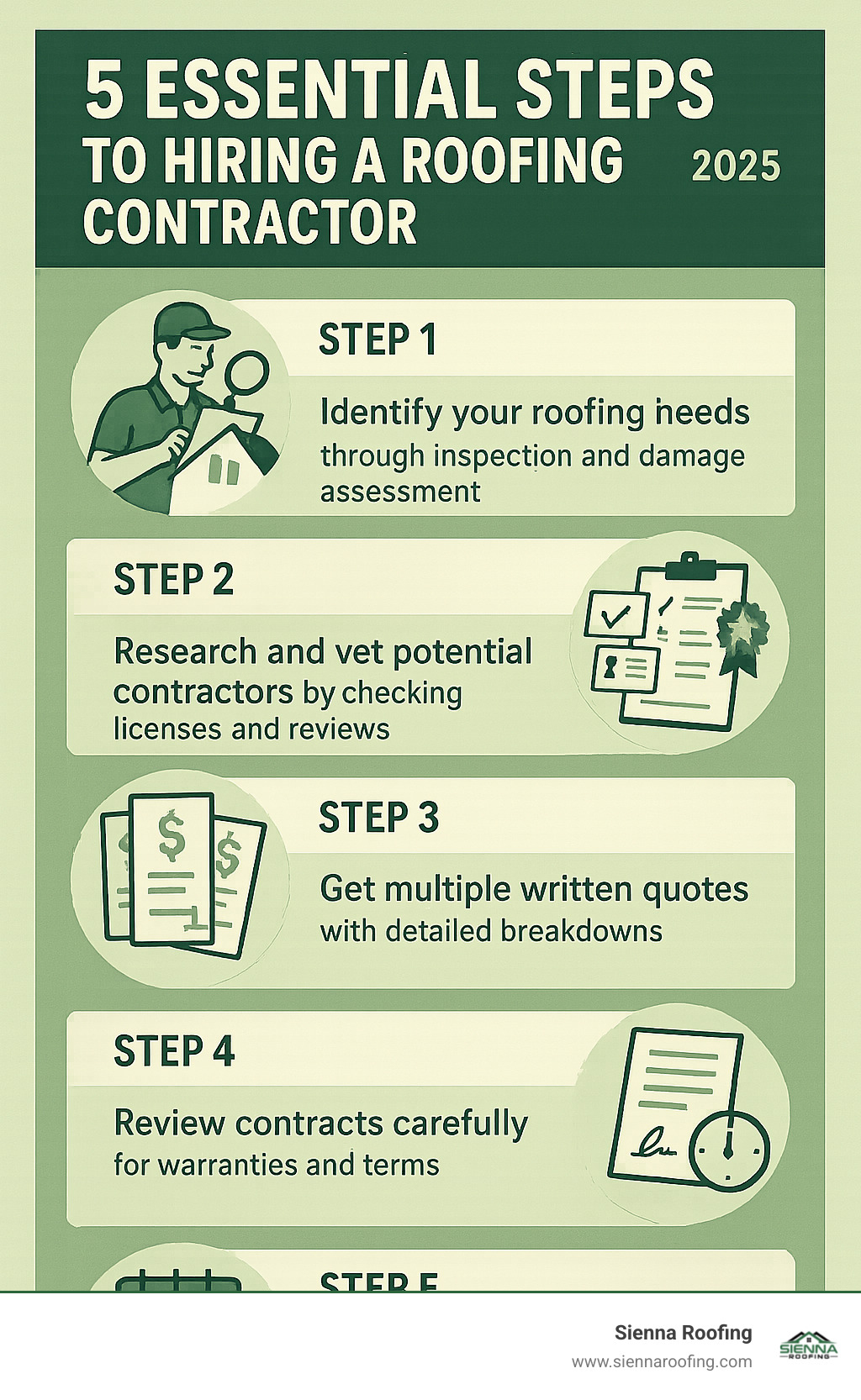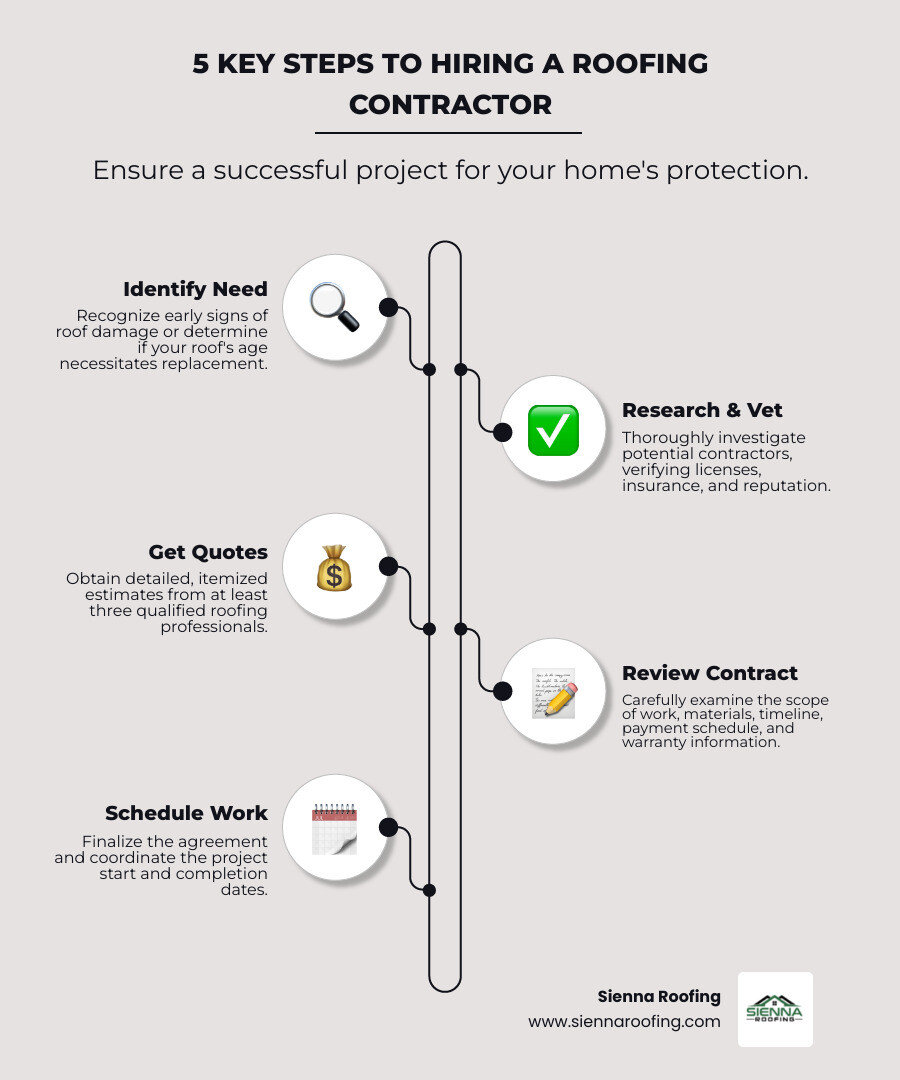Why Choosing the Right Roofing Contractor Matters for Your Home’s Future
Your roof is your home’s first and most critical line of defense against the elements. It shields your family, your possessions, and the very structure of your house from rain, wind, hail, and the intense Texas sun. While most residential asphalt shingle roofs have a lifespan of only 15 to 25 years, the quality of the installation and the expertise of the team behind it can make all the difference. Choosing a proven professional is one of the most significant decisions you will make as a homeowner, directly impacting your property’s safety, energy efficiency, and resale value.
Working with an experienced roofing contractor like Sienna Roofing ensures that every shingle is perfectly placed, every seam is sealed, and your entire roofing system complies with local building codes and manufacturer specifications. This meticulous approach is essential for validating warranties and preventing the costly consequences of a failed roof—from insidious leaks that cause hidden mold and wood rot to catastrophic failures during a hurricane or severe hailstorm. A poorly installed roof can also lead to frustrating insurance claim denials and a constant cycle of repairs. This comprehensive guide is designed to empower you with the knowledge to identify roof problems early, thoroughly vet local contractors, compare modern roofing materials, understand the fine print in contracts, and protect your significant investment through proactive maintenance and scam avoidance. Use these insights to steer your roofing project with confidence, ensuring your home remains dry, secure, and protected for decades to come.

Is It Time for a New Roof? 7 Telltale Signs of Damage

A failing roof often sends subtle signals long before a disastrous leak appears as a stain on your ceiling. Recognizing these early warning signs allows you to take proactive measures, potentially saving you thousands of dollars in repairs to insulation, drywall, and structural framing. If you observe any of the following issues from a safe vantage point on the ground, it’s time to schedule a professional inspection.
Detailed Signs Your Roof Needs Professional Attention
- Curling, Clawing, or Buckling Shingles: When shingles begin to lift and curl at the edges (cupping or clawing) or push upward from the middle (buckling), they are no longer effectively shedding water. This is often a sign of advanced age, excessive heat absorption from an improperly ventilated attic, or moisture trapped beneath the shingles. These distorted shingles are highly susceptible to being torn off by high winds, creating a direct entry point for rain.
- Missing or Damaged Shingles: A single missing shingle is a breach in your roof’s armor. The exposed underlayment is not designed for long-term exposure to UV rays and weather, and it can quickly degrade. Look for shingles that are completely gone, torn, or have significant cracks. Even hairline fractures can allow water to seep through, compromising the layers below.
- Excessive Granules in Gutters and Downspouts: The sandpaper-like granules on asphalt shingles are their primary defense against the sun’s damaging UV radiation. As a roof ages, it naturally sheds some granules. However, if you notice a large accumulation of these black, gray, or colored particles in your gutters, it’s a clear indication that your shingles are nearing the end of their functional life and have become brittle and vulnerable.
- Advanced Roof Age: An asphalt shingle roof’s lifespan is finite. If your roof is approaching or has surpassed the 20-year mark, it warrants a close professional evaluation, even if there are no obvious signs of failure. A seasoned contractor can assess its condition and help you budget for a replacement before a major issue arises.
- A Spongy or Bouncy Feel Underfoot: If you (or a professional) walk on the roof and notice soft, spongy, or bouncy spots, this is a serious red flag. It typically indicates that the underlying roof decking (the plywood or OSB sheathing) has been compromised by moisture and is beginning to rot. This weakens the entire roof structure and requires immediate attention.
- Visible Leaks, Water Stains, or Mold: The most obvious sign of a roof problem is evidence of water intrusion inside your home. Check your attic regularly for damp insulation, dark stains on the wood, or a musty odor, which can signal mold or mildew growth. Ceiling and wall stains are signs that a multi-layer defense system has already been breached, and the damage may be more extensive than it appears.
- Damaged or Deteriorating Flashing: Flashing consists of metal or plastic pieces that seal the seams around roof penetrations like chimneys, vents, and skylights, as well as in roof valleys. If this flashing is cracked, rusted, or has pulled away from the structure, it creates one of the most common sources of roof leaks.
Pay special attention to these high-risk areas. If you’ve spotted any of these issues, our comprehensive roofing services include a thorough, no-obligation inspection to accurately diagnose the problem and determine if a targeted repair or a full roof replacement is the most cost-effective and secure solution for your home.
Vetting Your Pro: The Ultimate Checklist for a Reputable Roofing Contractor

Choosing your roofing contractor is as important as choosing the materials themselves. The quality of the installation determines the longevity and performance of your new roof. A reputable roofer provides not only skilled workmanship but also peace of mind through legitimate credentials, robust insurance coverage, and solid warranties. Use this detailed checklist to diligently vet potential contractors and find a dependable local expert you can trust.
How to Find a Qualified Local Roofer
- Seek Local Recommendations: Start by asking for referrals from neighbors, friends, or colleagues who have recently had roof work done. A recommendation from a trusted source is invaluable. Ask them about their overall experience, the contractor’s communication, and how the final result has held up.
- Scrutinize Online Reviews: Dive deep into online reviews on platforms like Google, Yelp, and the Better Business Bureau (BBB). Don’t just look at the star rating; read the content of both positive and negative reviews. Look for consistent patterns in praise (e.g., professionalism, cleanliness, on-time completion) and complaints. A contractor’s professional and constructive response to negative feedback can also be very telling.
- Consult Professional Associations: Membership in organizations like the National Roofing Contractors Association (NRCA) indicates a commitment to professionalism and staying current with industry best practices. These directories can be a good starting point for finding established contractors.
- Verify a Permanent Business Address: A legitimate contractor will have a physical office, not just a P.O. Box or a temporary address. This signals stability and permanence, differentiating them from “storm chasers” who appear after severe weather and disappear just as quickly, leaving homeowners with no recourse for warranty issues.
Essential Qualifications for Any Roofing Contractor
- State Licensing and Registration: In Texas, roofing contractors are not required to have a state-wide license, but they can register with the Roofing Contractors Association of Texas (RCAT). More importantly, they must comply with local municipal requirements. Always confirm that the contractor is registered and in good standing with the relevant authorities, such as the Texas Department of Licensing and Regulation (TDLR) for related trades. You can use the license search for verification.
- Comprehensive Insurance Coverage: This is non-negotiable. Your contractor must provide current certificates for two types of insurance. General Liability Insurance protects your property from damage caused by the contractor’s work. Workers’ Compensation Insurance protects you from liability if a worker is injured on your property. Without it, you could be held financially responsible for medical bills and lost wages. Ask for the certificates and call the insurance provider to verify that the policies are active.
- Manufacturer Certifications: Top-tier roofing manufacturers like GAF, Owens Corning, or CertainTeed offer certification programs to contractors who meet stringent standards for quality, training, and financial stability. Hiring a certified contractor, such as a GAF Master Elite® roofer, often grants you access to superior materials and improved, longer-lasting warranties that are backed by the manufacturer.
Key Questions to Ask Before You Hire
- How long have you been in business under your current name in the local area?
- Can you provide a portfolio of recently completed projects and a list of local references I can contact?
- Will you provide me with your active certificates of insurance for both general liability and workers’ compensation before any work begins?
- What specific workmanship and material warranties do you offer? Can you provide the full documentation for me to review?
- Do you use your own employees or subcontractors? If you use subcontractors, are they fully insured and licensed to the same standards?
- Who will be the on-site project manager and my primary point of contact?
- What is your detailed plan for protecting my landscaping, driveway, and siding during the project?
- How will you handle cleanup, and what does your daily and final cleanup process entail?
- What is the realistic timeline for the project, from start to finish, and what are the potential causes for delays?
When evaluating a roofer in Katy, TX, asking for addresses of local projects is a great way to see their work and assess the quality and consistency of their installations.
Decoding the Details: Materials, Contracts, and Modern Roofing Tech

The long-term success and durability of your new roof depend on making informed decisions about the materials you choose and ensuring every detail is codified in a comprehensive contract. Understanding your options and the legal framework of your project is crucial for a smooth process and a lasting result.
Choosing Your Armor: A Detailed Comparison of Roofing Materials
| Material Type | Cost (Relative) | Lifespan (Years) | Pros & Cons |
|---|---|---|---|
| Asphalt Shingles | $$ | 15-30 | Pros: Affordable, wide variety of styles/colors, easy to install. Cons: Shorter lifespan, susceptible to hail/wind damage, less eco-friendly. |
| Metal Roofing | $$$ | 40-70 | Pros: Extremely durable, energy-efficient, fire-resistant, lightweight. Cons: Higher upfront cost, can be noisy without proper insulation. |
| Tile (Clay/Concrete) | $$$$ | 50-100+ | Pros: Exceptional lifespan, superior fire resistance, unique aesthetic. Cons: Very heavy, may require structural reinforcement, brittle and can crack. |
- Asphalt Shingles: The most popular roofing material in North America, asphalt shingles offer a fantastic balance of performance and value. They come in two main types: traditional 3-tab shingles, which offer a flat, uniform look at a budget-friendly price, and architectural (or dimensional) shingles, which are thicker, have a more varied, high-definition appearance, and offer a longer lifespan and better wind resistance. For Texas homeowners, investing in Class 4 impact-resistant shingles is a wise choice, as they are designed to withstand hail and may qualify you for a discount on your homeowner’s insurance. Explore various looks in this comprehensive shingle style guide.
- Metal Roofing: Once relegated to commercial buildings and barns, metal roofing is now a premier choice for residential homes due to its longevity and performance. Standing seam metal roofs, with their clean, vertical lines, are highly effective at shedding water and are known for their durability. Other options include stone-coated steel tiles that mimic the look of shingles or tile. Metal roofs are highly reflective, which can significantly reduce cooling costs, and are resistant to fire, rot, and insects. Modern installation techniques and proper insulation ensure that noise from rain is no more noticeable than with other roofing types.
- Tile Roofing (Clay and Concrete): For a timeless, neat aesthetic, nothing compares to clay or concrete tile. Common in Spanish and Mediterranean-style architecture, tile roofs offer an unparalleled lifespan, often lasting for a century or more. They are completely fireproof and resistant to rot and insects. However, tile is extremely heavy and may require a structural engineer to verify that your home’s framing can support the additional weight. It is also more brittle than other materials and can crack if walked on improperly.
What Every Watertight Roofing Contract Must Include
A verbal agreement is not enough. A professional roofing contract is a detailed document that protects both you and the contractor. Insist on a written contract that clearly specifies:
- Detailed Scope of Work: This should outline every step of the process, including the tear-off of the old roof, inspection and replacement plan for damaged decking, type of underlayment and ice/water shield to be used, flashing replacement, ventilation improvements, and the specific installation method.
- Specified Materials: The contract must list the exact brand, product line, and color of the shingles, metal panels, or tiles being installed. Vague descriptions like “high-quality shingles” are unacceptable.
- Project Timeline: It should include a projected start date and an estimated completion date, acknowledging that weather can cause delays.
- Payment Schedule: A clear schedule of payments is crucial. Avoid contractors who demand a large upfront payment. A typical schedule might be a third to start, a third at a midway point, and the final third upon satisfactory completion and inspection. Never make the final payment until you are completely satisfied.
- Lien Release Clause: This is a critical protection for the homeowner. It states that upon your final payment, the contractor waives their right (and their subcontractors’ and suppliers’ rights) to place a mechanic’s lien on your property.
- Permit and Inspection Responsibility: The contract should state that the contractor is responsible for obtaining all necessary building permits and scheduling all required municipal inspections.
- Change Order Process: It should define the process for handling unforeseen issues or homeowner-requested changes, including how they will be documented and priced in writing.
The Future is Bright: Cool Roofs and Other Innovations
Modern roofing technology offers more than just shelter. Cool roofs are designed with materials that reflect more sunlight and absorb less heat. According to the U.S. Department of Energy’s cool roofs overview, this can lower roof surface temperatures by up to 50°F, reducing the energy needed to cool your home. Proper attic ventilation, including soffit, ridge, and gable vents, is a critical component of any roofing system, as it helps to expel hot, moist air, extending the life of your roof and lowering energy bills. When upgrading, also consider impact-resistant shingles for hail-prone areas and sustainable materials to reduce your environmental footprint.
Protecting Your Investment: Insurance, Maintenance, and Scam Prevention
A new roof is a significant investment that, with proper care, can protect your home for decades. Understanding how to steer insurance claims, perform routine maintenance, and spot potential scams will ensure you get the maximum value and lifespan from your roof.
Navigating Storm Damage Insurance Claims
Dealing with insurance after a storm can be a stressful process. Following these steps can help streamline your claim:
- Ensure Safety and Document Damage: After a storm, and only when it is safe to do so, document any visible damage from the ground. Take clear, time-stamped photos and videos of dented gutters, damaged siding, and any visible marks on your shingles. This initial documentation is crucial.
- Contact Your Insurer Promptly: Call your insurance company to open a claim as soon as possible. They will assign you a claim number and schedule a visit from an insurance adjuster.
- Get Multiple Contractor Estimates: Obtain at least three detailed, written estimates from reputable, local roofing contractors. This will give you a clear understanding of the scope of work and fair market pricing. A professional estimate should include a line-item breakdown of materials and labor.
- Have Your Contractor Meet the Adjuster: Whenever possible, arrange for your chosen contractor to be on-site when the insurance adjuster conducts their inspection. An experienced roofer can point out damage that an adjuster might overlook, ensuring a more accurate and comprehensive assessment.
- Review the Adjuster’s Report Carefully: Before you agree to any settlement, review the adjuster’s report line-by-line with your contractor. This report will detail the scope of damage they are covering and the valuation, which could be either Replacement Cost Value (RCV), which covers the full cost to replace, or Actual Cash Value (ACV), which deducts for depreciation. Understanding your policy is key.
How to Avoid Common Roofing Scams
Unfortunately, the roofing industry can attract dishonest operators, especially after a major storm. Protect yourself by watching for these red flags:
- Out-of-Town “Storm Chasers”: Be wary of contractors with out-of-state license plates who knock on your door immediately after a storm. They often perform shoddy work and disappear, leaving you with no warranty or recourse.
- High-Pressure Sales Tactics: A reputable contractor will provide a detailed estimate and give you time to consider it. Avoid anyone who pressures you to sign a contract on the spot or offers a “special deal” that expires today.
- Large Upfront Payments: Demanding a large deposit or the full payment in cash before work begins is a major warning sign. A professional company with good credit will have the means to purchase materials without needing a massive down payment. Stick to a milestone-based payment schedule.
- Vague Verbal Promises: Never rely on verbal agreements. If a promise about a warranty, material upgrade, or timeline isn’t in the written contract, it doesn’t exist. Insist that every detail is documented.
- Offers to Cover Your Deductible: A contractor who offers to waive or absorb your insurance deductible is encouraging you to commit insurance fraud. This is illegal and can have serious consequences for you as the homeowner.
Simple Maintenance to Extend Your Roof’s Lifespan
- Inspect Visually Twice a Year: In the spring and fall, perform a visual inspection from the ground using binoculars. Look for any of the warning signs mentioned earlier.
- Keep Gutters and Downspouts Clear: Clogged gutters cause water to back up and seep under the edge of your roof, potentially rotting the decking and fascia boards. Clean them at least twice a year.
- Trim Overhanging Branches: Tree limbs rubbing against your roof can scrape off granules, while falling branches can cause significant impact damage. Keep them trimmed back.
- Remove Debris: After a storm, check for and remove any leaves, pine needles, or other debris that has collected in roof valleys or around chimneys, as this can trap moisture.
Service Area and Contact
Sienna Roofing
17034 University Blvd, Sugar Land, TX 77479
Phone: (832) 564-3322
Conclusion: Your Partner for a Secure and Lasting Roof
Your home is likely your most valuable asset, and a sound, professionally installed roof is the ultimate guardian of that investment. The process of replacing a roof can seem daunting, but by arming yourself with knowledge, you can make confident decisions that ensure decades of security and peace of mind. From identifying the subtle, early signs of wear and tear to carefully vetting contractors for their credentials and local reputation, every step is crucial. Understanding the distinct advantages of different materials—whether the value of architectural asphalt, the longevity of metal, or the timelessness of tile—allows you to tailor the project to your budget and your home’s needs.
Furthermore, insisting on a detailed, transparent contract and being vigilant about proactive maintenance are the final pieces of the puzzle. These practices safeguard you from scams and help you maximize the lifespan of your new roof. At Sienna Roofing, we believe an informed homeowner is our best partner. We are committed to providing not just superior materials and expert installation, but also the guidance and transparency you deserve. Ready to protect your home with a high-quality roof installed by a team that values integrity and craftsmanship? Contact Us today for a free, no-obligation estimate!
Vetting Your Pro: Quick-Check Summary for Hiring Confidence
Finding the right team is critical for a long-lasting roof. Use this rapid screening process before requesting bids to ensure you’re dealing with a true professional:
- Verify Credentials: Confirm local registrations and ask for current, verifiable certificates of both general liability and workers’ compensation insurance. Use the Texas TDLR search for related trade licenses.
- Check Reputation: Scrutinize recent reviews on Google, Yelp, and the BBB. Prioritize established local contractors with a permanent physical address, not post-storm pop-ups.
- Ask for Proof: Request a portfolio of local work and a list of recent references you can contact.
- Demand Clarity: Ensure all proposals are detailed and itemized. Confirm that written warranties, property protection plans, and cleanup procedures are clearly defined before signing any contract.
Materials and Contracts, Simplified
Your choices in materials and the details of your contract will define your roof’s durability and your peace of mind. Here’s a simplified guide:
- Materials Breakdown: Choose Asphalt Shingles for value and variety (consider impact-resistant options for Texas hail). Select Metal for exceptional longevity and energy efficiency. Opt for Tile for a premium aesthetic and century-long lifespan, but confirm your home’s structure can support the weight.
- Contract Essentials: Your contract is your protection. It must detail the full scope of work, specify exact material brands and types, set a timeline and payment schedule, and include a lien release clause. Never proceed without a comprehensive written agreement.
7 Signs You Should Inspect Your Roof Now
A quick refresher on the critical red flags that demand immediate attention. If you spot these from the ground, it’s time to call a professional:
- Visible Wear: Shingles that are curling, buckling, cracked, or missing.
- Accelerated Aging: An accumulation of shingle granules in your gutters.
- Structural Warnings: A spongy or soft feel underfoot (a sign of rotted decking).
- Water Intrusion: Leaks or dark water stains appearing on ceilings or in the attic.
- Compromised Seals: Damaged or deteriorating flashing around chimneys, vents, and in roof valleys.
The Shortlist: How to Identify a Trustworthy Roofing Contractor
Quickly narrow down your options to find a reliable roofer with these core principles:
- Go Local and Proven: Prioritize local companies with a permanent business address and a long history of positive reviews.
- Verify Insurance and Licensing: Always ask for and verify current certificates for general liability and workers’ compensation insurance. Check for any required local or state credentials.
- Look for Certifications: Manufacturer certifications (e.g., GAF Master Elite®) often mean better training and access to superior warranties.
- Ask the Right Questions: Inquire about their use of subcontractors, project timelines, property protection plans, and cleanup protocols to avoid surprises.
Decoding the Details: Materials, Contracts, and Modern Roofing Tech

Make your material and contract decisions with confidence by focusing on these key points:
- Choose Materials Wisely: Balance lifespan (Asphalt: 15–30 years, Metal: 40–70, Tile: 50–100+) with your budget, climate, and home’s structure. For Texas, prioritize heat reflection and hail resistance.
- Insist on a Detailed Contract: Your agreement must be in writing and specify the full scope of work, product names, project dates, payment milestones, and a lien release.
- Accept Modern Tech: Consider cool-roof materials and robust attic ventilation to lower energy bills. Impact-rated shingles offer crucial resilience against Texas hailstorms.

Is It Time for a New Roof? A Quick Recheck
Still deciding whether it’s time to call a professional? Revisit these essential warning signs that your roof’s integrity may be compromised:
- Surface Wear: Look for curling, cracking, or missing shingles, and check your gutters for a heavy loss of protective granules.
- Hidden Damage: Be aware of soft spots on the roof deck or any visible water stains and leaks inside your attic or on your ceilings.
- High-Risk Zones: Pay close attention to the flashing and seals around valleys, vents, and chimneys, as these are common failure points.
Hiring Confidence: Final Contractor Vetting Notes
Before you sign a contract, perform this final check to ensure you’re hiring with complete confidence:
- Validate All Credentials: Re-verify licensing where applicable (e.g., TDLR search for related trades) and call the insurance carrier to confirm the contractor’s policies are active.
- Clarify Responsibilities: Confirm in writing who is responsible for pulling permits and scheduling all necessary inspections.
- Understand Warranties: Get both the material and workmanship warranties in writing and make sure you understand what is covered and what is excluded.
- Match Proposals: Ensure all proposals are “apples-to-apples,” specifying the exact same brands, products, and installation methods for a fair comparison.
Modern Roofing, In Brief: Materials, Contracts, Innovation
Here are the key takeaways for making smart, modern roofing choices:
- Materials: Asphalt shingles offer the best value; Metal provides superior longevity and energy efficiency; Tile delivers a premium aesthetic and maximum durability.
- Contracts: Demand a detailed written agreement covering everything: scope, products, timeline, payment schedule, lien releases, and a formal change-order process.
- Technology: Use innovation to your advantage. Cool roofs and proper ventilation reduce heat gain and lower energy costs, while impact-rated shingles add critical protection against severe weather.





